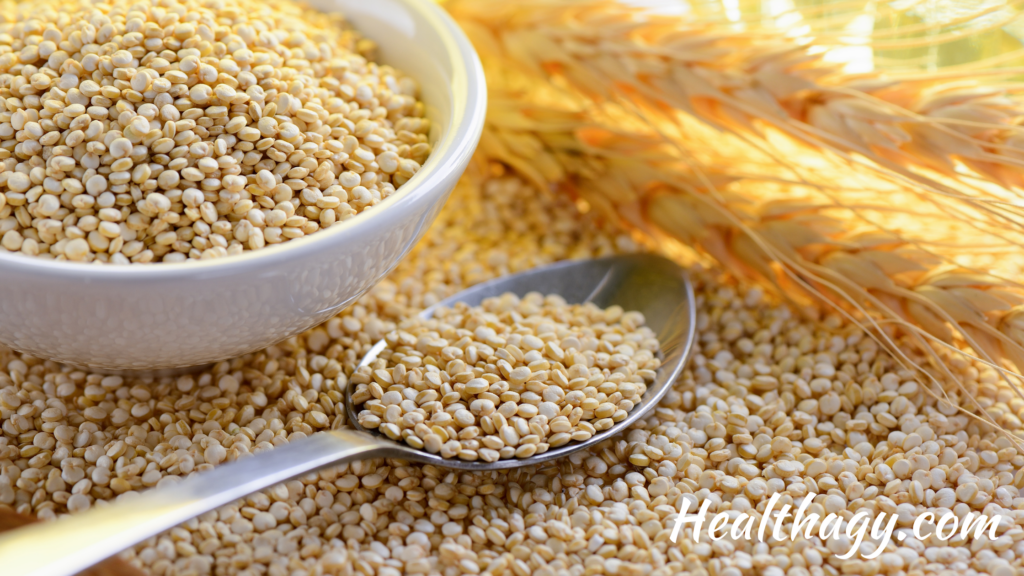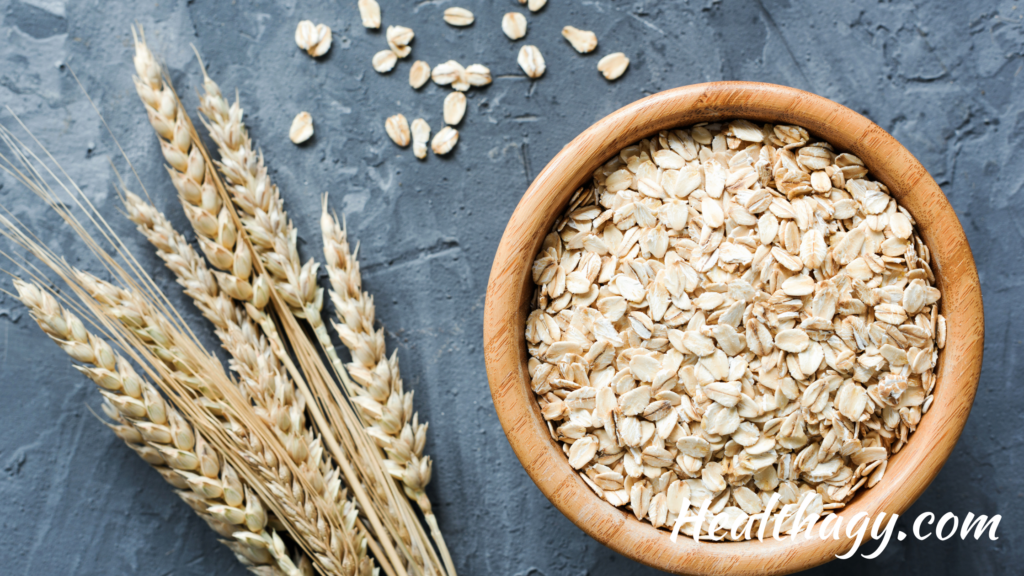Do you love warm food in the morning? Or are you a cold cereal person? Either way, quinoa, and oats are two great options for breakfast. While oats have been traditionally used to make breakfast oatmeal, quinoa is a great substitute and can also be used in making a similar type of breakfast dish. With both of these options for breakfast, which is the healthier option, does quinoa or oats provide more health benefits?
This post will break down your questions and compare the nutritional and health benefits of these two whole grains.
Key Differences in Quinoa vs Oats
The main difference between quinoa vs oats is that quinoa has more protein, with8.1 g or 16% of the daily value per one cup serving, while oats contain5.9 g or 12% of the daily value. Quinoa is a complete protein source, while oats are not. Quinoa also contains more dietary fiber, which helps to support a healthy digestive system.

What is Quinoa?
Quinoa is a very popular superfood for those who eat a plant-based diet and those who are focused on healthier foods. Quinoa is an excellent source of protein and fiber while also being a good source of various other vitamins, minerals, and antioxidants, all of which give quinoa the title of superfood.
Although quinoa is “newer” to the United States, it’s actually a seed that has been eaten for thousands of years, dating back to the Incan Empire, when they were regarded as a sacred food and the “mother of all grains.” They are scientifically known as the plant Chenopodium quinoa.
While quinoa or quinoa seeds are nutritionally considered to be a whole grain, they are technically a seed, making them a “pseudo-grain.”
While white quinoa is the most common variety of quinoa you’ll find at the grocery stores, it comes also comes in red and black quinoa varieties. While they all have a similar taste, they have some slight variations in their texture and flavor.
The thing that sets quinoa aside from several other grains and pseudo-grains, including oats, is that it is a complete protein source containing all nine essential amino acids. One cup of cooked quinoa contains approximately 8.1 grams of protein.
Quinoa is naturally a gluten-free food and a great option for anyone with celiac disease, gluten sensitivity, and those on gluten-free diets. While quinoa is naturally gluten-free, if you have Celiac disease, have a gluten allergy, or are on a strict gluten-free diet, don’t forget to look for the certified gluten-free stamp.
Quinoa Taste
Quinoa has an overall bland taste, with a slightly nutty flavor, making it a versatile grain that can easily be substituted for oats, rice, and other grains. It cooks up fluffy, with a light, chewy texture.
Quinoa can also be found in a variety of gluten-free products, such as quinoa flakes, bread, and other gluten-free products, making it a great gluten-free option.

What are Oats?
Oats are also an ancient grain; they are roasted after harvest, which gives them a unique and distinct flavor. Oats have been around for hundreds of years and a breakfast staple in many homes worldwide as oatmeal or porridge. Oats are commonly used in baking and other breakfast foods such as oatmeal cookies, muffins, pancakes, and gluten-free breads, and they are sometimes even added to smoothies.
Nutritional Comparison Quinoa vs Oats
Below are the key nutritional value profiles for one cup of quinoa (cooked) and one cup of oats (cooked).
| 1 cup serving of quinoa (cooked), % Daily Value | 1 cup serving of Oats (cooked), % Daily Value | |
| Calories | 222 | 166 |
| Total Carbohydrate -Dietary fiber -Sugar – Added Sugars | 39.4 g, 13% 5.2 g, 19% 1.6 g, 3% 0 g | 28.1 g, 9% 4.0 g, 14% 0.6 g, 1% 0 g |
| Protein | 8.1 g, 16% | 5.9 g, 12% |
| Total Fat Saturated Fat | 3.6 g, 5% 0.4 g, 2% | 3.6 g, 5% 0.7 g, 4% |
| Vitamin D | 0 mcg | 0 mcg |
| Calcium | 31.5 mg, 2% | 21.1 mg, 2% |
| Iron | 2.8 mg, 15% | 2.1 mg, 12% |
| Potassium | 318.2 mg, 7% | 163.8 mg, 3% |
| Phosphorus | 281.2 mg, 22% | 180.2 mg, 14% |
| Magnesium | 118.4 mg, 28% | 63.2 mg, 15% |
| Zinc | 2 mg, 18% | 2.3 mg, 21% |
| Vitamin C | 0 mg | 0 mg, 0% |
| Vitamin E | 1.2 mg, 8% | 0.2mg, 1% |
| Manganese | 1.2 mg, 51% | 1.4 mg, 59% |
| Selenium | 5.2 μg, 9% | 12.6 μg, 23% |
| Thiamin (Vitamin B1) | 0.2 mg, 16% | 0.2 mg, 15% |
| Riboflavin (Vitamin B2) | 0.2 mg, 16% | 0 mg, 3% |
| Niacin (B3) | 0.8 mg, 5% | 10.5 mg, 3% |
| Vitamin B6 | 0.2 mg, 13% | 0 mg, 1% |
| Folate (B9) | 77.7 μg, 19% | 14 μg, 4% |
Health Benefits of Quinoa and Oats
Energy Source
Quinoa contains39.4 grams of carbohydrates or 13% of the daily value, while oats contain slightly less carbohydrates with 28.1 grams or 9% of the DV. Carbohydrates from a whole grain diet, such as quinoa and oats, provide the body with glucose, which is converted to energy used to support energy levels in your body.
Dietary Fiber
Both quinoa and oats are good sources of fiber. Quinoa has a slightly higher dietary fiber content, with5.2 g or 19% per cup, and oats have 4.0 g or 14% per cup.
The dietary fiber in quinoa is roughly 2/3 insoluble fiber and 1/3 soluble fiber. While oats have a bit more soluble fiber than insoluble, they still contain good amounts of each type of fiber.
Consuming both types of fiber is important as they both have great benefits. Soluble fiber forms a gel that helps to improve digestion as it moves through your system. It also helps to enhance stool bulk and lower blood sugar and cholesterol levels.
Insoluble fiber supports water in your stool, preventing constipation and helping to keep your intestines healthy.
The fiber in quinoa and oats may also help support lowering cholesterol and blood sugar levels, which may also help support heart health and lower your risk of diseases such as diabetes and heart disease.
Excellent Protein Source
Quinoa is an excellent source of protein, especially for those on a plant-based diet. Quinoa has a high protein content, containing8.1 g or 16% of the DV per one cup serving, while oats contain5.9 g or 12% of the DV.
The extra advantage quinoa has, besides having a higher protein content, is that it is also considered a complete protein source, containing all nine essential amino acids. Where oats do contain all nine essential acids but do not qualify as a complete protein as the lysine content is very low, so it is important to also consume another food with a higher amount of lysine.
Helps Manage Blood Sugar Levels
About one cup of quinoa is considered to be a low glycemic index food. Quinoa is a great source of dietary fiber, and the soluble fiber in quinoa helps lower cholesterol and supports gut health, while its insoluble fiber prevents constipation.
Oats vary in how they impact blood sugar levels depending on what type of oat they are. Rolled oats have a moderate glycemic index of about 59, whereas instant oats have a high glycemic index of around 83.
Quinoa is likely your best option if you have blood sugar level concerns or are at risk of diabetes, as the fiber and protein may help regulate blood sugar levels. However, it is always best to consult your doctor on which foods are best for you.
Supports Healthy Weight Management
It’s important to note that various factors influence weight loss and weight management. When it comes to healthy weight management, quinoa is a greater source of insoluble fiber than oats which helps increase the feeling of fullness, keeping you fuller for longer, which may support weight loss. The dietary fiber and protein it contains also help increase metabolism and reduce food cravings, which may decrease calorie intake.
Overall Health
Both quinoa and oats also contain a variety of vitamins and minerals, such as significant amounts of iron, phosphorous, magnesium, zinc, manganese, and several b vitamins, all of which help to support overall health.
Key Takeaways
Oats and quinoa have similar nutritional values and health benefits. With breakfast being the most important meal of the day, both of these foods are great nutritious grains to start your day, having both energy-filled carbohydrates and protein.
They both offer significant health benefits, making each a great addition to a healthy diet, and are a better choice than processed breakfast cereals.
It is common to find oats and quinoa being used in various gluten-free foods, making them a healthy alternative to traditional wheat products.
Read More:
How Long Does Cooked Quinoa Last?
Karla Kueber is a Certified Evidence Based EFT Practioner and Health Coach, with a double Masters Degree in Education. She works with people to overcome emotional eating, curb cravings, and overcome resistance to eating new healthy foods. You can learn more about coaching with her here.
